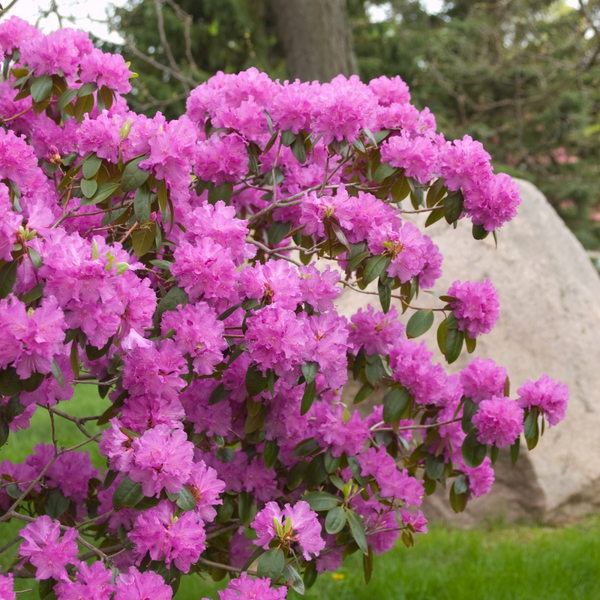
Fothergilla
Uses:
- Border Plant
- Hedges & Privacy
- Specimen or Focal Point
Features:
- Attracts Pollinators
- Foliage Interest
- Fragrant Flowers In Early Spring
Sunlight:
- Full Sun To Part Shade
- At Least 3 Hours Of Direct Sunlight
Growing Zones:
- 4-9
- What is My Zone?
Fothergilla is a deciduous shrub known for its fragrant, bottlebrush-like flowers in the spring and colorful fall foliage in shades of red, orange, or yellow. It can be used as a striking specimen plant, a border shrub, or as part of a mixed hedge, adding seasonal interest and texture to the garden.
About Fothergilla

Witch Alder
Southeastern United States
Bushes
Deciduous
4 to 8
White
Late spring to early summer
Dense, bushy, rounded
Pollinators
Drought
Deer and most pests
How To Use Fothergilla In The Garden
Fothergilla offers distinctive brush-shaped ivory flowers composed solely of stamens, appearing in spring without petals. Following the bloom, its emerald leaves unfurl, providing lush greenery throughout summer. In autumn, the foliage transforms into a rich tapestry of mauve, red-orange, and chartreuse hues. This deciduous shrub offers visual interest across all four seasons, making it a valuable addition to any garden.
Fothergilla's compact size, ranging from 3 to 10 feet, makes it suitable as a foundation plant, contributing structure and form to planting schemes. When used in mixed borders, it complements perennials and evergreen shrubs, enhancing the overall visual appeal. Its tolerance for partial shade allows for flexible placement under tree canopies or in woodland settings. Busy gardeners will appreciate fothergilla's adaptability, along with its slow growth and low-maintenance requirements.
Types of Fothergilla
| Type | Scientific Name | Native Range | Flower | Habit | Mature Size | Uses | Features |
|---|---|---|---|---|---|---|---|
| Large Fothergilla, Mountain Witch-Alder | Fothergilla major | Mountains & Piedmont of AL, GA, SC, NC, TN | Creamy-white, honey-scented bottlebrush spikes (male & female flowers mixed); showy stamens | Multi-stemmed, upright-oval shrub, can be rangy | 6–10 ft | Specimen, mixed shrub borders, naturalistic woodland plantings, informal hedge | Tolerates drier, poorer soil than F. gardenii; showy twigs with zig-zag pattern; vivid late-season color |
| Dwarf (Coastal) Fothergilla | Fothergilla gardenii | Coastal plain savannas & pocosins of SC & NC | Creamy bottlebrush spikes, fragrant | Dense, rounded, suckering shrub | 3–5 ft (wider with suckers) | Foundation plant, low hedge, rain-garden edge, pollinator gardens | Best in moist, acidic soil; spreads by suckers; outstanding fall color; good for very wet conditions |
| Hybrid Fothergilla | Fothergilla × intermedia (F. gardenii × F. major) | Garden origin (first noted Arnold Arboretum 1980) | Bottlebrush blooms intermediate in size; fragrant | Intermediate, mounded–upright; hybrid vigor | 5–7 ft; dwarf selections 2–3 ft | Specimen, mixed borders, four-season color accent | Combines best traits: good moisture tolerance, adaptable to drier soils, prolific bloom, intense fall display |
Fothergilla Care
Fothergilla thrives in moist, loamy, acidic soil with good drainage. Plant it during spring or autumn in a location that receives 6 to 8 hours of direct sunlight daily. Water the shrub deeply when the top inch of soil feels dry, and apply a 1-to-2-inch mulch layer to retain moisture, especially if situated in full sun. Fertilize monthly during spring with a product formulated for acid-loving plants.
Pruning is minimal; remove dead, diseased, or damaged branches in late winter to enhance air circulation and promote healthy growth. After flowering in late spring, trim any suckers to keep growth in check. In regions with harsh winters, protect the plant by loosely tying branches with twine and covering them with burlap or a frost blanket. Fothergilla adapts well to container growth; select a pot slightly larger than the root ball and use soil designed for acid-loving plants.
Learn More About Fothergilla Care

Fothergilla Companion Plants
Choose companions that accept full sun in spring, slightly acidic, moist‑but‑draining soil, and cold winters. Ninebark echoes Fothergilla’s April bloom and matches its frost hardiness, while witch hazel repeats the leaf‑before‑flower trick to lengthen the shoulder season of interest. Azalea gains extra light through Fothergilla’s bare branches then receives cooling cover in midsummer, and hosta knits a weed‑smothering, low‑light carpet around the base without vying for canopy space.










